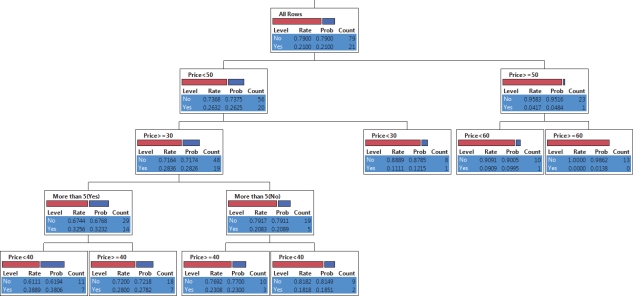SCENARIO 17-3
The tree diagram below shows the results of the classification tree model that has been constructed to predict the probability of a cable company's customers who will switch ("Yes" or "No")into its bundled program offering based on the price ($30,$40,$50,$60)and whether the customer spends more than 5 hours a day watching TV ("Yes" or "No")using the data set of 100 customers collected from a survey.


-Referring to Scenario 17-3,the highest probability of switching is predicted to occur among customers who do not watch more than 5 hours of TV a day and are offered the bundled price of lower than $50.
Definitions:
Mental Accounting
The process by which individuals categorize and evaluate economic outcomes by organizing them into specific accounts in their minds.
Framing Bias
A cognitive bias where people decide on options based on whether the choices are presented with positive or negative connotations.
Positively Correlated
A relationship between two variables where they move in the same direction, meaning as one variable increases, the other does as well.
Trading Activity
The volume or quantity of buying and selling transactions in a financial market over a specific period.
Q5: The prescriptive analytics technique in which the
Q34: Referring to Scenario 16-13,what is the exponentially
Q45: Referring to Scenario 19-5,the best estimate of
Q55: Referring to Scenario 18-11,what is the p-value
Q106: Referring to Scenario 16-9,if one decides to
Q113: The opinions (classified as "for","neutral" or "against")of
Q146: Referring to Scenario 14-17,which of the following
Q157: Referring to Scenario 19-8,an x̄ chart is
Q219: Referring to Scenario 14-15,the null hypothesis should
Q235: An agronomist wants to compare the crop